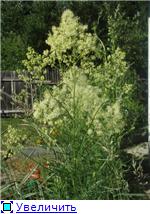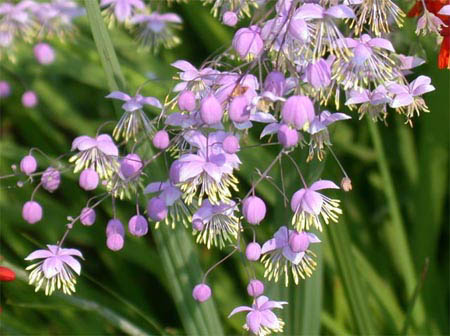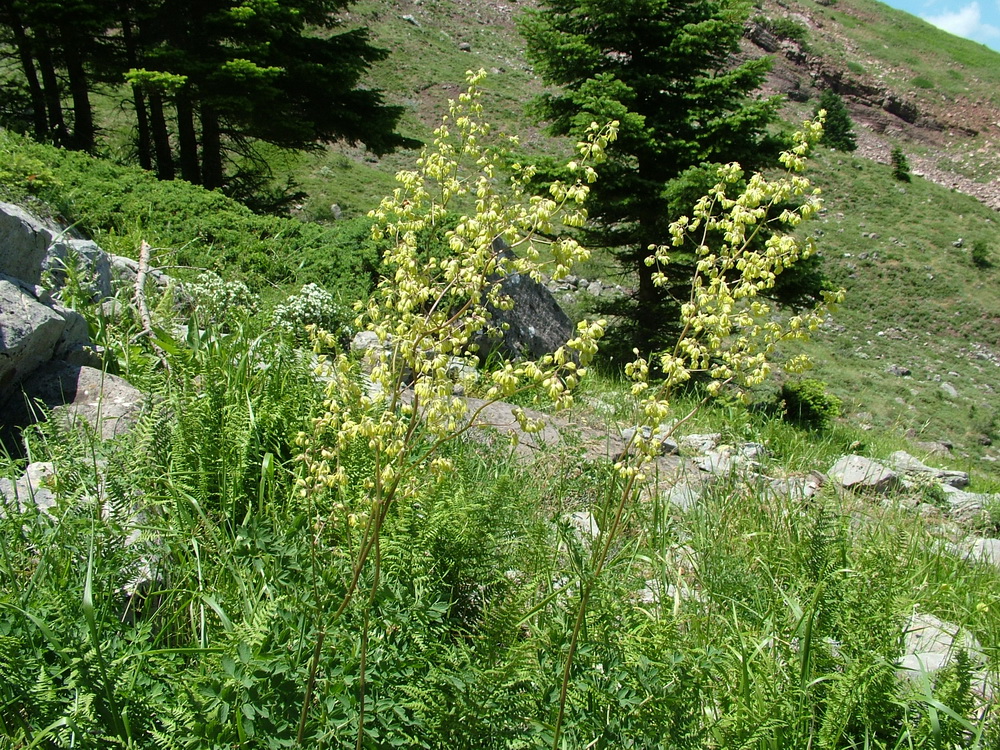Basil small: use in folk medicine. Small basil plant.
"Happiness is the natural state of man!" mistletoe herbalist
Again, I will consider the species that are found in our lane. Upon further consideration of the buttercups, there will be corrections to the spring chistyak in terms of its possible danger - after all, not all buttercups are so fierce!
In general, at the end I will try to generate a generalized post on buttercups.
General description:
small basil(wild parsley, rutwitz, rutka) is a perennial edible plant from the buttercup family with pinnately divided leaves. Decorative foliage and undemanding in the garden. There are many types of basil, differing in both the height and size of the leaves, and the color of the inflorescences. You should look for a plant in the steppes, steppe meadows, along the slopes of the beams, in thickets of shrubs, in damp places. He loves water very much.
The ancient Greek name Thalictrum minus comes from the words "thalos" - green branch and "icter" - imploring. The plant looks like an olive branch wrapped in down. Such a branch meant a prayer for protection. Graceful foliage, as follows from the popular name of the most famous representative of the genus, resembles the foliage of watersheds (aquilegia), with which cornflowers are combined into one subfamily. In English-speaking countries, their foliage is compared with rue in terms of delicacy and wax coating, and the name of the plant sounds like “meadow rue” - meadow rue.
The plant is 50-100 cm high. The leaves are thrice-or four-pinnate, double-pinnate, with small, obovate, 3-notched or lobed leaves at the top. Flowers in a loose spreading panicle, greenish, yellowish stamen filaments. Blooms in June-July. The fruit is a polynutlet (ribbed achene).
Gardening notes:
Basils propagate by seeds and division of bushes. Seeds can be sown in the fall on ridges in the ground, in the spring in protected ground after a month of stratification or in winter in boxes and after 5-7 days taken out under the snow, the seedlings must be planted on the ridges. Seedlings bloom in the second year. They are undemanding to the soil, they grow well both in open sunny places and in slightly shaded ones. special care do not require. The plant is frost-resistant and winter-hardy. Used for planting in flower beds on the north side garden house, near ponds and cut for bouquets.

Beneficial features:
Young leaves and shoots are used in food as a seasoning for dishes.
Medicinal raw materials are leafy tops herbs, up to 60 cm long. The plant is harvested during the flowering period (usually June-July), dried on fresh air in the shade, periodically mixed, and stored in linen bags for up to 3 years. Darkened and yellowed raw materials are not suitable for use. The roots are dug in September-October.
Decoction, infusion and tincture cornflower have antibacterial, antitumor, tonic, diuretic, laxative, hemostatic and wound healing effects. They are prescribed for acute and chronic infections (measles, smallpox, typhoid, dysentery, tuberculosis, anthrax, malaria), diseases of the digestive system, inflammation of the gallbladder and liver, mucous membrane of the stomach and small intestine, diarrhea, as well as gangrene of the extremities and pain in a stomach. Used for nervous disorders and especially epilepsy.
Raw basil is used for edema, women's diseases (in particular, for painful menstruation) and as a cardiovascular remedy. It is effective for malaria, pulmonary tuberculosis, jaundice, metabolic disorders, nosebleeds, colds, rheumatic pains.
Steamed and pounded leaves are a good wound healing agent for purulent wounds.
Roots used for acute and chronic infections. Ointment or powder is useful for boils (chirps). Tincture herbs used to lower blood pressure and in heart attacks. It is prepared on 70% alcohol in a ratio of 1:10. Insist 7-10 days. Take 20-40 drops 3 times a day with meals. The course of treatment is 3-4 days
For decoction 15 g of roots are poured into 180 ml of boiling water, insisted on a bath for 30 minutes, cooled for 10 minutes, filtered. Take 2 tbsp. spoons 3 times a day after meals.
For cooking infusion 6 g of raw materials are poured with 1 cup of boiling water, kept in a closed enameled bowl in a water bath for 10 minutes, infused for 1 hour, filtered through two or three layers of gauze and the volume is adjusted boiled water to the original. Store in the refrigerator for up to 2 days. Take 1-2 tablespoons 3 times a day with meals. Course of treatment 5
Tincture small cornflower has a satisfactory effect in the early stages of hypertension, angina pectoris, circulatory disorders. In Tibetan medicine, medicines from leaves and roots were prescribed for heart edema and some gynecological diseases.
Basil is part of the collection for cooking potions M.N. Zdrenko for the treatment of cancer, peptic ulcers, gastritis!
Official medicine allows only this type of basil to be collected.
Precautions:
It has little toxicity, but good tolerance. Some sources contain information about the toxicity of the plant, but there is no such information on medical and botanical sites. Given the active effect of the plant on the nervous and cardiovascular system, do not abuse doses or duration of use - overdoses are fraught with the opposite effect (which is true for many soothing plants) - increased pressure, excessive heart rate, increased nervous excitability.
Plants from different districts and habitats have an unequal alkaloid composition, that is, they have varying degrees of toxicity, but in general they are quite small. The general chemical composition may also vary.
General character and magical properties:(looks like the truth, but can be added)
It treats heart diseases (even strokes), cancer, peptic ulcers, cleanses the blood and normalizes metabolism. Widely used in women's diseases. Gently cleanses, disinfects and stimulates healing.
This is a plant with long time ago used to treat many female diseases and is considered a female love spell. It is recommended to sprinkle chopped tomatoes with finely chopped cornflower grass to ignite passion and desire in a woman, but for men, the use of cornflower has the opposite effect, so this plant can also be used to turn away and eliminate sexual desire.
With all this information and appearance plants, one gets the impression that it is closer in character to water, which for some reason I am more convinced of. It can be used as a light protective amulet, or an amulet for love or friendship (allegedly the American Indians used it that way). Female soft plant.

The basil is simple.
General description:
Thalictrum simplex
According to the description chemical composition and properties are very similar to the small cornflower.
The leaves are dissected into oblong-wedge-shaped, deep-lobed lobes. The panicle is pyramidal. Flowers and stamens drooping, greenish, stamen filaments pale pink. More common in forest edges and clearings than in meadows.
AT folk medicine water infusion and decoction of the plant are used for various female diseases and as a tonic in the postpartum period.
Infusion is washed with wounds and gargle with sore throat. The grass is applied to cuts to speed up their healing, and it is also used to make poultices with flux, washing with purulent wounds.
It has vasodilating and choleretic properties. Lowers blood pressure and increases the number of heartbeats.
Basil yellow
General description:
Thalictrum flavum (scrofula, daisy). perennial plant 50-150 cm tall, with a creeping rhizome. The leaves are alternate, compound with rounded obovate, dull leaflets above, 20-50 mm long. The flowers are fragrant, light yellow or greenish-white, collected in a dense thyroid panicle. Stamens straight, yellow.
Distributed on the edges of swampy forests, among shrubs and reed bogs, near rivers.
Deciduous and ornamental flowering plant, planted in groups.

Useful properties (see small cornflower):
It is used in folk, but not official medicine. Seems to have more causticity due to alkaloid content.
The plant has a laxative, diuretic, antipyretic, sedative, anti-inflammatory, antiseptic, hemostatic and wound healing effect.
Also, in different sources, the stinky basil is often mentioned, but I did not find any differences in the description at all. Not mentioned in medical books.
And there are many more ornamental varieties, the contemplation of which brings real pleasure.

Collection according to Zdrenko's prescription:
I - collection: six-petaled meadowsweet roots - 20 g, calamus roots - 20 g, marshmallow roots - 20 g, barberry roots - 20 g, valerian roots - 20 g, elecampane roots - 20 g, yellow iris roots - 20 g, capsule rhizome yellow - 20 g, white capsule rhizome - 20 g, hard comfrey roots - 20 g, horse sorrel roots - 20 g, juniper fruits - 20 g, annual dried flower herb - 7 g, mountaineer grass - 7 g, common yarrow flowers - 7 g, laxative joster berries - 5 g.
II - collection: avran officinalis herb - 3 g, small cornflower herb - 7 g, spring adonis herb - 7 g, Laxman's tenacious herb - 7 g, prickly goose grass - 7 g, dioica nettle herb - 7 g, silver cinquefoil herb - 7 g, flowers May lily of the valley- 7 g, peppermint leaf - 7 g, tansy flowers - 7 g, medicinal leaves - 7 g, five-lobed motherwort herb - 7 g, chamomile flowers - 7 g, medicinal sage leaves - 7 g, Ethiopian sage herb - 7 g, sandy immortelle flowers - 7 g, common wormwood grass - 7 g, tripartite grass - 7 g, horsetail grass - 7 g
Common basil.
Thalictrum minus.
Buttercup family - Ranunculaceae.
Description. Small basil - perennial herbaceous plant buttercup families up to 60 cm high. The stem is straight or ascending, tetrahedral at the top. Rhizome horizontal, segmented, brown.
Leaves opposite, sessile, ovate-lanceolate, with three longitudinal veins. Blooms from June to autumn. Flowers solitary, on long peduncles. The fruit is an ovoid, multi-seeded capsule. Seeds are small, reticulate-wrinkled. They begin to ripen in July.
Place of growth. Small basil is common in the European part of Russia, in the Caucasus, in Western Siberia and Kazakhstan. Grows in damp places, in water meadows and river banks among small shrubs.
collection time.
Medicinal raw materials grass serves. Harvest it during flowering, cutting off the leafy part of the plant. Dry outdoors in the shade or in an attic with good ventilation, laying out in a thin layer. Store in bags in a dry place for up to 3 years.
Legend. According to legends, this plant received its Russian name in honor of the epic beauty Vasilista Vikulichna, who decided to arbitrarily die after her beloved husband, the hero Mikhailo. On the very spot where the lifeless Vasilista fell, a hitherto unseen flower grew.
By the way, perhaps it is thanks to this mythical story that folk rumor persistently ascribes properties to the basil that make it an extremely desirable component in the manufacture of love remedies and decoctions.
active substances. Small cornflower roots contain steroids and alkaloids (talikmiq, talikmidin, etc.); aerial part - saponins and alkaloids (malmine, talmidine, etc.), vitamin C, tannins, aliphatic hydrocarbons.
Application. Decoction, infusion and tincture have antibacterial, antitumor, tonic, diuretic, laxative, wound healing effects. They are prescribed for acute and chronic infections (measles, smallpox, typhoid, diphtheria, pulmonary and skin tuberculosis, anthrax, malaria, syphilis), diseases of the digestive system, inflammation of the gallbladder and liver, mucous membrane of the stomach and small intestine, diarrhea, as well as with gangrene of the extremities, abdominal pain, colds, nervous disorders and epilepsy.
The aerial part of the plant is part of Zdrenko's prescription for the treatment of cancer. Raw basil is used for edema, women's diseases, as a cardiovascular remedy. Steamed and crushed leaves are a good wound healing agent for purulent wounds. The roots are used for acute and chronic infections. Ointment or powder is useful for boils. The herb tincture is used to lower blood pressure and for heart attacks.Recipes. Infusion. 6 g of raw materials are poured with 1 cup of boiling water, kept in a closed enameled bowl in a water bath for 10 minutes, insisted for 1 hour, filtered through 2-3 layers of gauze and brought to the initial volume with boiled water. Store in the refrigerator for up to 2 days. Take 1 - 2 tablespoons 3 times a day with meals. The course of treatment is 5 - 7 days.
Tincture. Prepared with 70% alcohol in a ratio of 1:10. Insist 7 - 10 days. Take 20 - 40 drops 3 times a day with meals. The course of treatment is 3 - 7 days.
(common) is a perennial from the Ranunculaceae family.
It is also called:
- cinchona grass;
- silverfish (due to a slight coating on the leaves);
- root.
Description
This is a low (up to a meter) plant in comparison with its fellow basil plants on a short knotty rhizome. The leaves are planted on a long petiole, the plants become smaller towards the top. Inflorescences of greenish flowers are collected in panicles. On the territory of Russia, the small cornflower is found in Altai, the Far East. In Latin, the plant is called Thalictrum, the word was formed from the Greek words for "green branch" and "asking". This name is given because of the similarity of the plant in the olive branch, which in Ancient Greece symbolized a request for help, protection.
In the Far East, cabbage soup is prepared from a young cornflower, grass is used as a side dish for meat and fish. This is a very valuable nutritional supplement in the spring, when there is a shortage of fresh herbs and vitamins. Silver can be found in the garden as ornamental plant: it grows as an openwork bush, and during flowering in the middle of summer it turns into a greenish misty cloud, which looks especially impressive in drops of dew or rain. This type of basil was used when painting the canvas yellow.
Compound
Like all members of the family, the small cornflower is poisonous because it contains a wide range of alkaloids. At the same time, the young grass of the plant is eaten without harm by domestic herbivores. In addition to talmin, talmidin, berberine and talicrin, a dangerous substance in the composition of the small cornflower is cyanide glycoside, which can decompose to hydrocyanic acid (this is a strong poison). Poisonous substances are found in all parts of the plant. The herb contains a lot of vitamin C, flavonoids, alkanes, saponins and tannins, and the roots also contain steroids. Like other species of this plant, silverwort accumulates a significant amount of lithium, which leads to its use as a means for regulating nervous system.
Medicinal properties
The healing properties of the small cornflower are recognized by official medicine only in part. For example, the herb of the plant is part of the antitumor collection No. 99 according to Zdrenko's prescription, which is used for benign and malignant neoplasms, polyps, adenoma.
In folk medicine, the plant is valued by many peoples. For example, in Tibet, cornflower is used for cardiac edema, gynecological inflammation. The name cinchona grass was fixed due to the fact that the plant has a healing effect on the human body similar to the bark of the cinchona tree. It is used for malaria, bladder papillomatosis, and anacid gastritis. Preparations based on the small cornflower kill bacteria.
Medicinal use
For the needs of traditional medicine, both grass (during flowering) and plant roots (in autumn) are harvested. Cut off the top 40 cm of grass. Dry in bundles or on paper, under a canopy. Small cornflower is stored for 3 years.
Recipes
Many recipes for all types of cornflower used for medicinal purposes will be similar, since the plants are similar in chemical composition.
Infusion of roots for cardiac edema:

1 tsp roots are poured into a glass hot water. Infuse for 60 minutes, drain. Drink 2 tbsp. infusion 3 times a day for half an hour before meals. Store infusion in cool place no more than 2 days.
Infusion of herbs from high blood pressure:
1 tsp dry raw materials are infused with 250 ml of boiling water. Take 1 tbsp. 3 times a day before meals. The course of treatment for hypertension is 1 week.
Infusion for bedsores:
1 tbsp chopped fresh or dry herbs insist on a glass of boiling water for an hour. Treat affected areas.
fresh leaves
can be used to treat small ulcers, diaper rash in adults. It is enough to attach a washed sheet to the site of the lesion.
Contraindications
Do not forget about the high toxicity of plant components: do not exceed the dose. Preparations based on small cornflower are prohibited for use by children, pregnant and lactating women. Also a contraindication is low blood pressure.
|
Latin name: Thalictrum minus L. Family: Ranunculaceae |
belongs to the family called buttercups. AT Latin the name of this plant will sound like this: Thalictrum minus L.
Description of the small basil
The small basil is a perennial herbaceous plant, which is endowed with a creeping rhizome, grayish in color. The stem of the plant is naked, in height it ranges between fifty and one hundred and twenty centimeters. The leaves of the plant are triangular, they can be either three-pinnate or four-pinnate. The small cornflower inflorescences are sprawling, the panicles are quite rare, and the flowers are small and drooping, greenish-brown in color. The inflorescences are endowed with ten to fifteen drooping stamens, while the anthers are endowed with a pointed end, and the fruitlets will be ovate-elliptical in shape, such fruitlets reach only one millimeter in length.
The flowering of the small basil falls on the period starting from June and ending with the month of July. This plant is in natural conditions found in the European part of Russia, as well as in Central Asia and Ukraine.
Description of the medicinal properties of small cornflower
Small basil is characterized by quite valuable medicinal properties: for this purpose, not only the roots are used, but also the aerial part of this plant. The aerial part of the small cornflower should be collected during the flowering period of this plant. After the collection has taken place, the leaves should be cut off up to half of the stem, while the lower part of the stem should be discarded. As for the roots of the small basil, they should be prepared in the autumn period of time.
In the grass of the small cornflower there is ascorbic acid, phytoncides, pyrocatechins, tannins, as well as the following alkaloids: talmine and talmidin. The roots of the plant contain talikmidin, taliktrimin, talmin, talikmin, glaucine and berberine. A glycoside was found in the leaves of the plant; when split, it has the ability to release hydrocyanic acid.
It is noteworthy that each alkaloid is endowed with a variety of properties. Talmin promotes depression of the central nervous system and muscle relaxation, and also very effectively reduces blood pressure. As for talikmin and talikmidin, they contribute to the appearance of a cataleptic state in animals, while taliktrimin will stimulate the muscles of the uterus, and berberine has the ability to exert a laxative, diuretic and choleretic effect. In addition, berberine can also lower blood pressure. In addition, berberine has also been shown to have a therapeutic effect in both malaria and leishmaniasis.
Small basil is recommended to be used in homeopathy not only for painful menstruation, but also for poor eyesight. As for decoctions and infusions prepared from small basil, they are recommended for use in epilepsy, malaria and enterocolitis, which will also be accompanied by diarrhea. Also, such drugs are also effective in pulmonary tuberculosis, hemoptysis, colds, edema of various origins, and also in conditions of increased excitability of the nervous system. Small cornflower powder is considered effective means with festering wounds: these wounds should be powdered with this powder.
It is noteworthy that when ingesting preparations that include small cornflower, a considerable degree of caution should be observed: after all, this plant is poisonous. For diarrhea, it is recommended to take the following remedy: for its preparation, you will need to take one tablespoon of the crushed plant for one glass of boiling water. This mixture should be infused for one hour, and after that the mixture must be filtered. It is recommended to take this decoction three times a day, one tablespoon.


